Book Chapters
Creative Placemaking’s “Long Tail” (2025)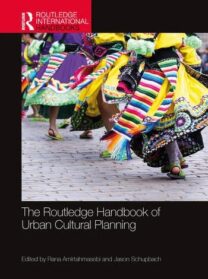
For The Routledge Handbook of Urban Cultural Planning, Anne Gadwa Nicodemus contributed the chapter, “Creative Placemaking’s ‘Long Tail.'” It explores the lasting implications of creative placemaking as a cultural policy precedent. It rigorously integrates findings from the literature and case studies with Gadwa Nicodemus’ first-hand knowledge as a leading researcher/writer focusing on arts-based community development. It recounts how creative placemaking emerged as coordinated cultural policy, even in the fragmented US cultural policy context. The attributable factors include: consensus on the pressing opportunity of how the cultural sector could contribute to place-based revitalization in the Great Recession, the power of persuasive leadership, incentives of new access and influence, an emphasis on cross sector collaboration, and a buzz-generating name and economic justifications for longstanding practices. It charts creative placemaking’s major growing pains and evolution, including rejection of the term and articulation of inequitable/unethical applications and eventual centering of systems change as the ultimate end-goal for key funders. To help practitioners build upon the lessons-learned and wisdom from the decade plus that creative placemaking has been a formal cultural policy and practice, the chapter highlights critical resources, notably key funders’ conceptual frameworks. It then connects readers to leading arts-based work and resources on two of today’s most critical challenges: the climate crisis and repairing democracy. Purchase book.
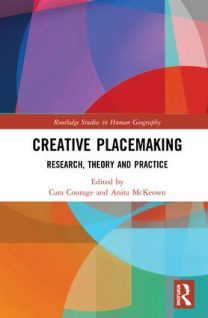 Creative Placemaking: Reflections on a 21st-century American Arts Policy Initiative (2019)
Creative Placemaking: Reflections on a 21st-century American Arts Policy Initiative (2019)
In the book Creative Placemaking: Research, Theory and Practice, Ann Markusen and Anne Gadwa Nicodemus co-authored the opening chapter, “Creative placemaking: Reflections on a 21st-century American arts policy initiative.” Markusen and Gadwa Nicodemus recount creative placemaking as a cultural policy shift, analyze ongoing challenges in the field, and review evaluation approaches. The book brings together a range of scholars to critique and deconstruct the notion of creative placemaking, presenting diverse case studies from researcher, practitioner, funder and policymaker perspectives from across the globe. Purchase book
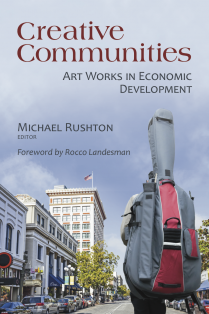 The Arts, Consumption, and Innovation (2013)
The Arts, Consumption, and Innovation (2013)
“The Arts, Consumption, and Innovation” explores the limitations of the dominant theory that exports drive overall city and regional economic growth. Using the context of arts and culture, it offers a complementary consumption base theory. It argues that incentives for capacity expansions of locally-oriented arts enterprises sustain jobs and incomes through four means. First, these enterprises offer residents opportunities to spend more of their discretionary income locally. Second, they provide a testing ground for artists and art works that later expand into export markets. Third, such incentives nurture organizations and occupations that re-spend high shares of income locally. Last, they help attract and retain residents, entrepreneurs, firms, and workers in non-arts sectors. By exploring variation in nonprofit arts and cultural activity across California regions and cities, the chapter probes the evidence for and against export vs. consumption based growth theories. By Ann Markusen, Anne Gadwa Nicodemus, and Elisa Barbour. A contributed chapter for Creative Communities: Art Works in Economic Development (Brookings Institution press, 2013). Purchase book
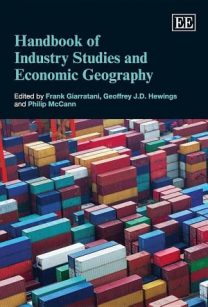
Spatial Divisions of Labor (2013)
In their contribution for the Handbook of Industry Studies and Economic Geography, Ann Markusen and Anne Gadwa Nicodemus argue that researchers and economic developers should shape regional job creation strategies by analyzing what workers do (occupational composition) as well as what they make (industrial composition). They document considerable variation in the occupational structure of specific industries across cities and regions, especially for innovative sectors such as high-tech, creative/cultural, business services, and information. Markusen and Gadwa Nicodemus speculate that on the causes of these patterns; they suggest that actors other than employers’ job offers or industrial agglomerations shape workers’ location choices, especially in high (artists, tech specialists) and medium-skilled (e.g. truckers, construction) occupations with high rates of self-employment. Their evidence includes an analysis of cultural industries and artist occupations for a subset of large US metros, and they innovatively define cultural industries as those with high concentrations of artistic occupations. Purchase book
Journal Articles
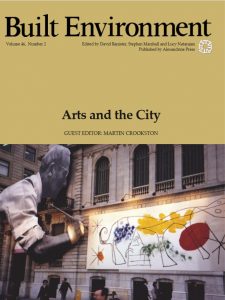
Arts and the City: Policy and Its Implementation (2020)
For a special “Arts and the City” issue of Built Environment, Ann Markusen and Anne Gadwa Nicodemus use the lens of the United States to offer a decade-long illustration of the implementation of a major policy initiative for art and culture across the nation’s cities and towns. We focus on the National Endowment for the Arts (NEA), and its companion ArtPlace and Our Town initiative around placemaking, as they have developed since 2009. We describe the challenges that almost eliminated the NEA in the 1990s, the subsequent advocacy shift towards the economic impact of the arts, and the emergence of the Our Town initiative in 2011. We analyze the policy initiatives, their rationales and implementation. We conclude with lessons and ways to improve practice in relation to the roles of artists and arts organizations covering issues of displacement, gentrification and racism (often unanticipated challenges for communities and funders); the impact of the arts in economic terms; and evaluative challenges for funders and placemakers, especially given cultural diversity and “placekeeping” priorities. Published journal article
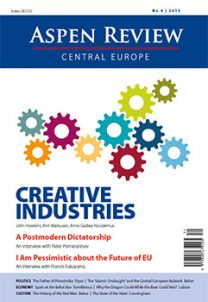
City Creative Industry Strategies: Unique American Cases (2015)
For a special issue of Aspen Review Central Europe, Ann Markusen and Anne Gadwa Nicodemus review three US cities’ outstanding efforts to design and implement creative industry strategies: Seattle, Washington: City of Music, a partnership to support musicians, music venues, a broad and diverse music industry, nonprofit music organizations, and researchers; San José, California’s ZERO1 Biennial and Garage, wedding art with technology and pairing tech companies with artists; and Providence, Rhode Island’s decades long innovative City support for creative workers and industries, such as tax-free arts districts, real estate assistance, and a new initiative that links growing design-based businesses with seed capital and mentorship. Read online
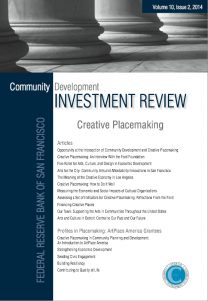
Creative Placemaking: How to Do It Well (2014)
In a special creative placemaking issue of the Community Development Investment Review for the Federal Reserve Bank of San Francisco, Ann Markusen and Anne Gadwa Nicodemus contributed “Creative Placemaking: How to Do It Well.”  In this article, they focus on the challenges in partnering, project design, securing finance, and evaluating progress. They go beyond the limits of their initial definition and case studies, adding insights from subsequent research, consulting, public speaking, and community engagement. Download pdf: Published journal article
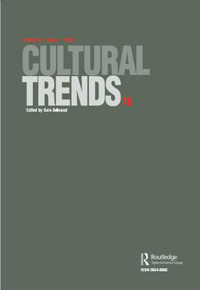 Fuzzy Vibrancy: Creative Placemaking as Ascendant US Cultural Policy (2013)
Fuzzy Vibrancy: Creative Placemaking as Ascendant US Cultural Policy (2013)
Gadwa Nicodemus contributed “Fuzzy Vibrancy” for a special issue of the UK-based journal Cultural Trends. The article introduces international audiences to creative placemaking as a major new US cultural policy and funding trend and contextualizes it within past patterns of arts-based economic and community development. Through an analysis of policy rhetoric and a sample of initiatives, it explores the interplay between policy and practice. It focuses on the challenges of a tendency towards “fuzzy concepts” within policy development. Download pdfs: Author’s accepted manuscript (free) | Published journal article
Short Articles
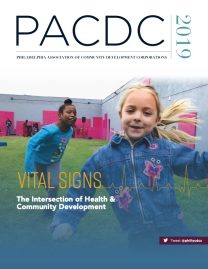
Songs and Stories of Community: How Place-Based Arts Can Lead to Health Equity (2019)
In this article for PACDC Magazine, Rachel Engh offers a snapshot of Metris’ forthcoming research on the relationship between place-based arts and culture and health equity and highlights the great work happening in Natchez, Mississippi. We found that communities can reduce social, health, and wellbeing disparities by building “social cohesion” (when individuals feel and act as part of a group that is oriented toward working together). When communities organize and act together, they’re better able to achieve community well-being and health equity. One way to foster social cohesion is for artists and arts organizations to join their neighbors in shaping their community’s future, working together to creatively address community challenges and opportunities. By strengthening a sense of belonging and common purpose, these place-based arts and cultural strategies can also increase community well-being and health equity. Download pdf
Project Evaluation as Art (2016)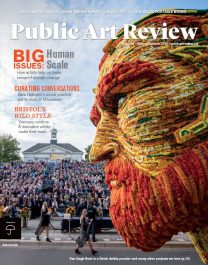
Measurement, assessment, evaluation: big, complex words that many people associate with stress, fear, or annoyance. But measuring the impact of your art-related work doesn’t have to be a necessary evil that rears its ugly head when you’re rushing to get grant paperwork out the door. In fact, evaluation can be an integral part of the creative process. Metris’ Rachel Engh unpacks these concepts in an article for Public Art Review. Read Online
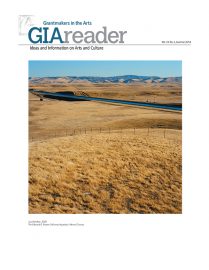 Small is Beautiful: Creative Placemaking in Rural Communities (2014)
Small is Beautiful: Creative Placemaking in Rural Communities (2014)
How does creative placemaking unfold in rural contexts? In this article for GIA Reader, Anne Gadwa Nicodemus explores the topic through the lens of four case studies. In Bakersville, North Carolina, community leaders adopted a regional peer-to-peer learning network to better leverage craft as an industry and physically revitalize their town. In Saint Helena Island, South Carolina, the Penn Center preserves and shares the area’s unique Gullah Geechee heritage, drawing over twenty thousand tourists annually. In New York Mills, Minnesota, a town found new life and relevance as a regional cultural hub and home for artist residencies. In Arnaudville, Louisiana, a cadre of resident volunteers led by an artist reshaped a small town around the arts, its Cajun heritage, and Francophone language preservation. Read Online | Download pdf
Creative Placemaking 101 for Community Developers (2014)
In an article for LISC’s Institute for Comprehensive Community Development, Anne Gadwa Nicodemus empowers community developers by focusing on creative placemaking fundamentals: strategic action by cross-sector partners, a place-based orientation, and a core of arts and cultural activity. Read Online
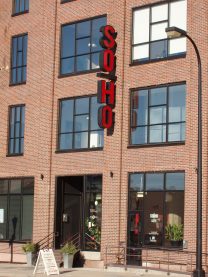 Artists and Gentrification: Sticky Myths, Slippery Realities (2013)
Artists and Gentrification: Sticky Myths, Slippery Realities (2013)
Hailed as “gentrification shock troops,” the perceived link between artists and gentrification is staunchly entrenched in the public imagination. In an article for Createquity.com, Anne Gadwa Nicodemus takes an unflinching look at complicity in neighborhood change and displacement. Substantive commentary exposes sticky myths and probes slippery realities.  Read Online
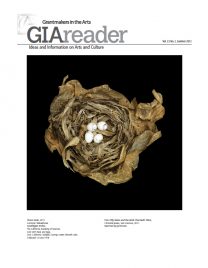 Creative Placemaking 2.0 (2012)
Creative Placemaking 2.0 (2012)
In an article for GIA Reader, Anne Gadwa Nicodemus unpacks creative placemaking today: our rapidly evolving understanding, major policy shifts, challenges around evaluating impact and equity concerns, and opportunities ahead. Read Online
Defining Creative Placemaking (2012)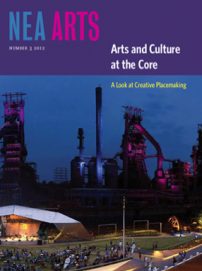
Ann Markusen and Anne Gadwa Nicodemus reflect on creative placemaking’s evolution in an interview for a feature story in NEA Arts Magazine. | Read Online
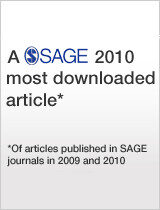
Arts and Culture in Urban and Regional Planning: A Review and Research Agenda (2010)
Published in a special issue of the Journal of Planning Education Research dedicated to art, culture and economic development. The most downloaded JPER article in 2010 from all articles published in 2009 and 2010, it is also one of nine selected for publication in a special Chinese edited volume that highlights the best of recent JPER articles. “Arts and Culture in Urban and Regional Planning: A Review and Research Agenda,” argues that most city cultural planning exercises do not have clear and measurable goals, do not understand either the causal relationships involved or institutional and design alternatives, and do not have access to studies that clarify the impacts, risks, and opportunity costs of various strategies, investments, and revenue and expenditure patterns. We review the state of knowledge about arts and culture as urban/regional development, exploring norms, summarizing the evidence on causal relationships, and addressing stakeholders, bureaucratic fragmentation, and citizen participation in cultural planning. The paper also examines designated cultural districts and tourist-targeted cultural investments as special cases. Read Online
